Hultafors Premium vs Standard Axes (Hands-on)
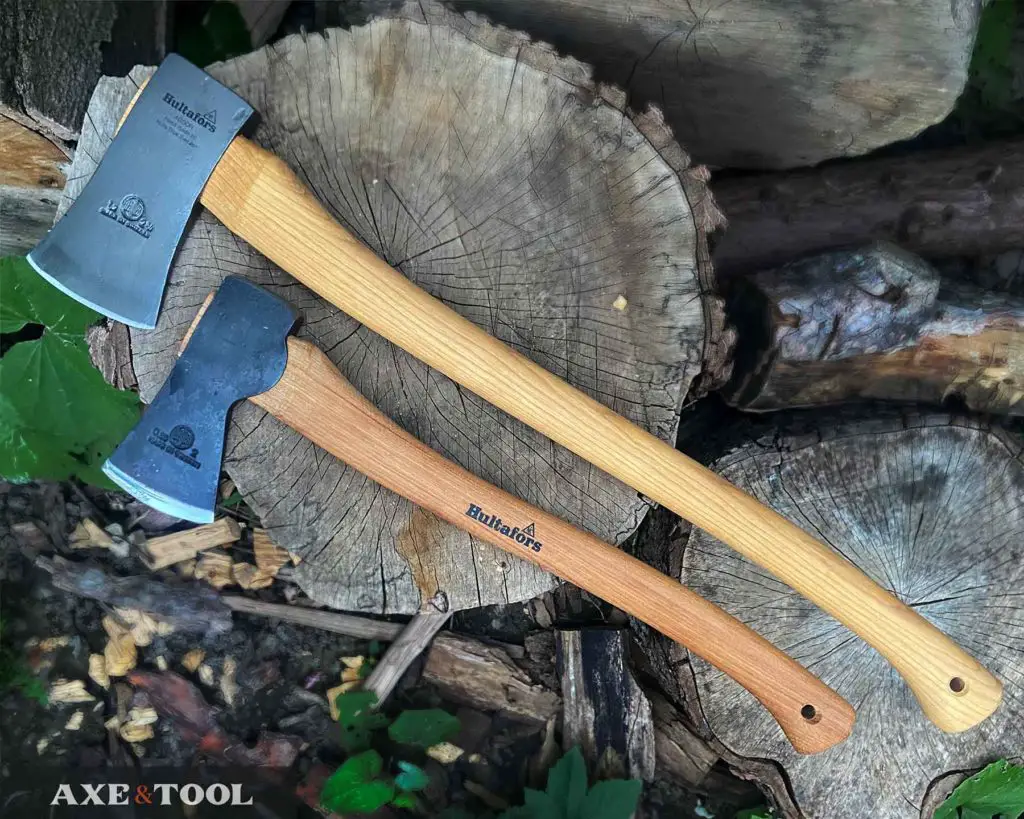
Hultafors premium axes are mainly small to midsize, with a sharp edge, controllable head, thinned handle, and leather sheath. They are designed for mobility and precise work. The standard axes are quickly sharpened, have thick handles, no sheath, Yankee pattern heads, and are better for heavier tasks overall.
Hultafors (Hults Bruk) is probably my favorite all-around axe maker today. I own a mix of both standard and premium models, and they are both excellent axes depending on what you are after.
The big deciding factor should be the different sizes and head shapes offered, that lend themselves to excel in different types of work.
Comparing the axe lines
| Premiuim Axes | Standard Axes | |
|---|---|---|
| Price | $$$ | $$ |
| Axe options | 8 | 14* |
| Felling axes | 1lb – 2lb | 1.25lbs – 4lbs |
| Felling pattern | Turpentine | Yankee |
| Splitting axes | 1 | 3 |
| Head Finish | Black forged | Grey sandblasted |
| Edge | Sharp, polished | Rough grind |
| Handle | Thinned oval | Thick round |
| Sheath | Leather | No |
| Details | Handle logo stamped | Blank handle |
While they are both made with excellent materials, the difference is in the details.
Premium Axes
The premium axes don’t need much work to be done out of the box. They come sharp with a nice handle and sheath. The finishing touches and tuning have been done at the factory.
I still give these new axes a proper oiling of the handle, but otherwise, I wouldn’t adjust anything until you’ve spent some time using it.
Standard Axes
The standard axes are quite a bit cheaper and can be put to work immediately. BUT – they won’t perform at their peak unless some of the extra finishing steps are done by you. Typically sharpening and maybe a bit of handle thinning.
These axes generally don’t come with a sheath either, which is something you should buy or make to keep safe.
Hultafors Felling Axes
The majority of Hultafors axes are felling axes. The most obvious difference between the premium and standard axes is the head pattern.
The premium line uses a Turpentine pattern while the standard axes use a much simpler Yankee pattern. While they have evolved, both these patterns have been in use for at least 125 years.
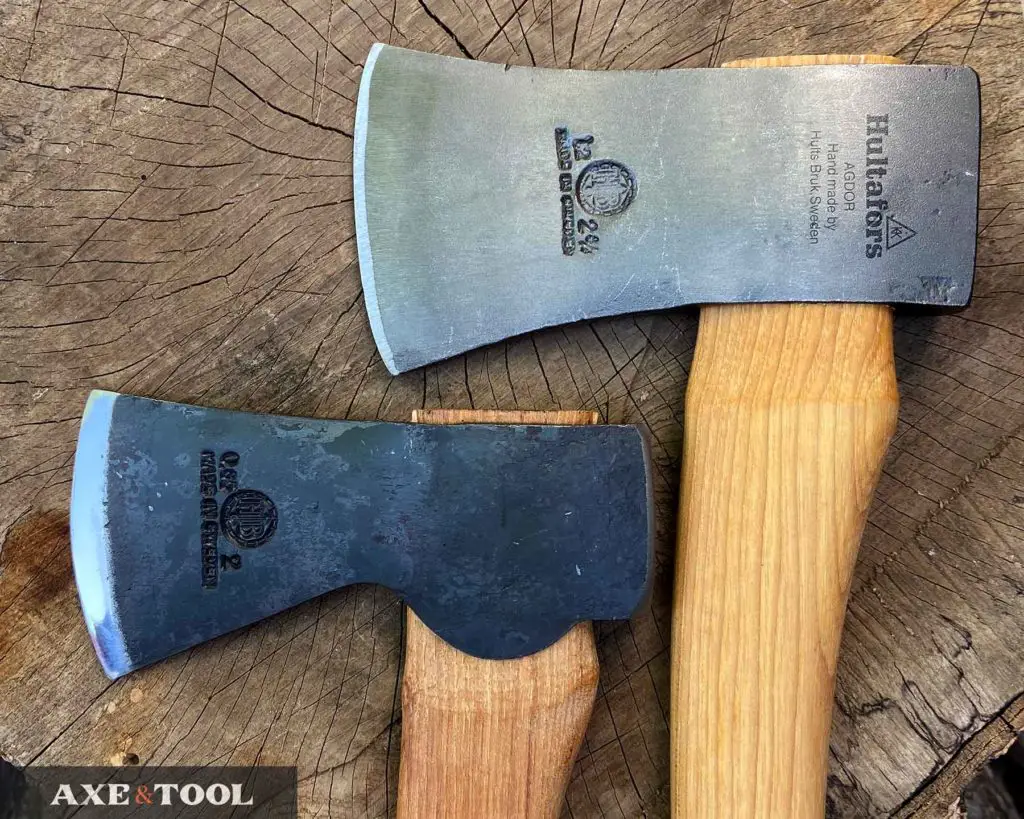
All Hultafors heads are stamped HB. Hultafors bought the axe maker Hults Bruk in the 90s, and now sell axes under both brands. We have an article comparing Hults Bruk vs Hultafors axe lines here.
Premium Felling axes
The Turpentine pattern head has a thinner narrow blade and a finger notch that allows the user to choke up on the handle and use the axe for finer work. The notch flows back to rounded lugs that keep the head on tight.
The heads have a fairly curved and narrow bit, which combined with the thin blade let them drive quite deep into the wood. I also like the deeper curve for detailed carving tasks.
The heaviest head is only 2lbs which means even the larger axes can be worked with one hand for precision work.
What I like about these heads compared to some other Swedish and European head patterns, is that there is a little bit of cheek swell in the middle – between the logo and the eye.
| Model | Type | Head | Handle |
| Ågelsjön | Felling | 1lb | 9.5″ |
| Hultan | Felling | 1lb | 15″ |
| Ekelund | Felling | 2lb | 20″ |
| Aby | Felling | 1.5lb | 24″ |
| Qvarfot | Felling | 2lb | 26″ |
Standard Felling Axes
The standard axes all use a Yankee pattern head – which is an American style pattern (if you can’t tell by the name). It’s a fairly simple shape with a square pole and mildly flared toe and heel. The simplicity makes it cheaper to produce.
Even though it’s made faster and cheaper, they still put in a little extra effort to grind a slight taper in the cheeks to the edges. This is a nice detail that isn’t usually seen on value axes and helps free your axe from larger wood.
The profile is closer to a wedge shape, making these heads a good versatile pattern. They can chop well and clear chips, as well as do some splitting. The heavier models (they go up to 4lbs) are some of the best for a big affordable “work axe” as they can flex into most roles.
The greatest feature of the standard line is the number of choices you have. While I love the large options for heavy work, they still offer smaller axes that you easily use for bushcraft, camping, trail work, etc. You just might need to do a little finer sharpening on your own if you plan to carve or do fine work.
| Model | Type | Head | Handle |
| H006 SV | Felling | 1.25lb | 15″ |
| H008 SV | Felling | 1.75lb | 17.75″ |
| H009 SV | Felling | 2lb | 20″ |
| HY10-0,8 SV | Felling | 1.75lb | 26″ |
| HY10-0,9 SV | Felling | 2lb | 26″ |
| HY 10-1,2 SV | Felling | 2.75lb | 28″ |
| HY 10-1,5 SV | Felling | 3.5lb | 32″ |
| HY 10-1,75 SV | Felling | 4lb | 32″ |
Note: Older models and unique axes are still sometimes available – the HY 20 for instance can still be found with a turpentine pattern head – but has been discontinued.
Are Hultafors axes sharp?
The premium axes come sharp. According to Hults Bruk (Hultafors), the premium axes get 10x more hand finishing time than the standard axes.[1]
The edges come finely ground in an even convex that ends in a 30-degree bevel. They also are polished to a mirror finish.
Keep in mind these are finished by hand so you will get some variations. My Ekelund came almost perfect, but my Ågelsjön (mini-hatchet) had a few transition lines and a little uneven edge at the heel – which is fine.
The Aby has a unique head that is similar to the turpentine pattern but has a longer cutting edge and flat grind edge, great for carving and shaping.
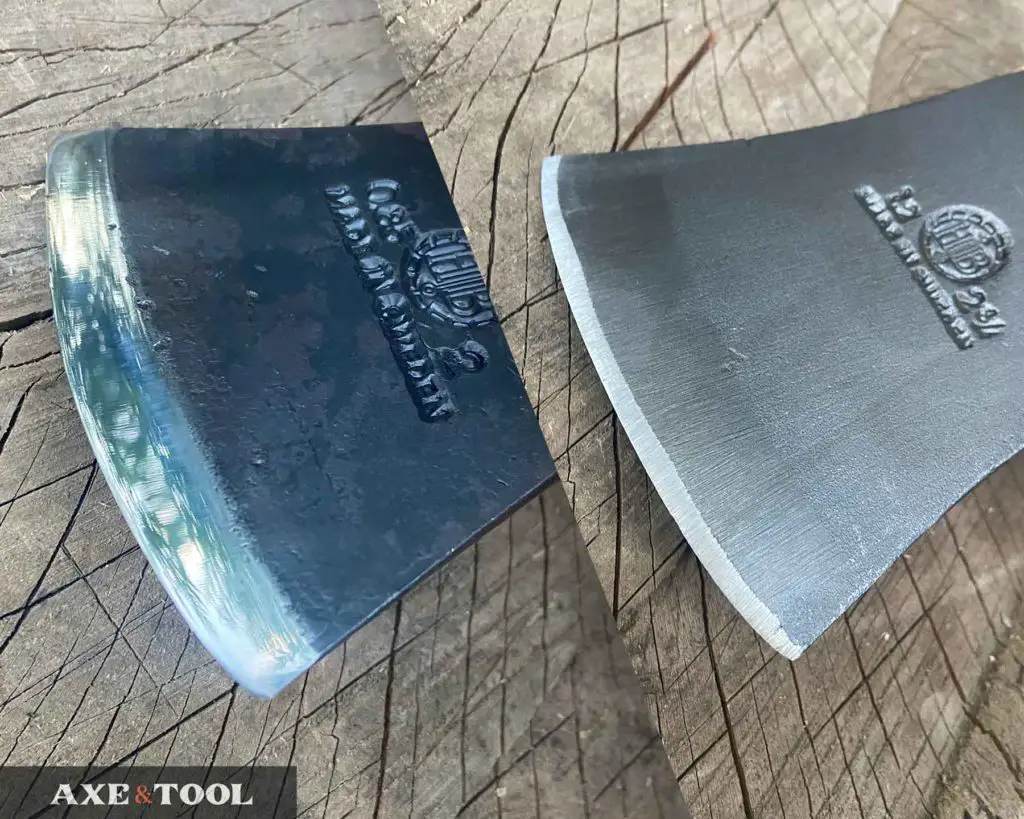
The standard axes are roughly sharpened.
It’s clear right away that the standard axes are sharpened with a quick pass under the grinder and that’s it. And for the price you pay, that is totally fine. I would consider it a “working edge” for general tasks for chopping and splitting. Likely a little uneven and maybe a bit off-center or inconsistent, but – it’ll do.
It’s still about a rough 30 degrees, but a little time with a file and/or sharpener will make these axes truly sing.
Surface Finish
Premium axes: The surface of the premium heads is a nice black(ish) forged finish. It will wear with time, but it’s really tough and slightly shiny and looks great. In the sun you might see some red tones – don’t panic, that’s not rust – it’s just left from the forging process.
Standard axes: The standard axes have been sandblasted and coated in some sort of flat grey finish. This coating will wear off with use much faster than the premium forge finish.

Premium axes come with a sheath
The premium axes come with a heavy leather sheath that covers the whole top of the head. It does up with a simple lanyard pull, which isn’t the tightest system – but it also won’t fall off.
The standard axes come with wax over the edge when you first get it, but no sheath.
Differences in the handles

Premium axe handles are better shaped:
The handles come with the logo embossed in the middle and have been thinned to a comfortable oval shape. The larger handles are a little under an inch (23-24mm), which is standard for this level of an axe.
The swell at the bottom flares out to a point at the front but stays a consistent width all the way through. This seems to be the norm for all Swedish-style handles. The flare does a pretty good job of catching your hand on its own.
They come adequately smooth, but I tend to hit them with a little 200 grit sandpaper before I add more coats of boiled linseed oil or wax.
You can see exactly how I sanded and oiled this Ekelund axe in my article on how to properly treat a handle.
Hultafors standard axe handles are nice (but fat)
The standard axe handles still come smooth but they are way fatter than the premium handles, almost round. The larger 28” and above handles are particularly chunky. I have 3 and they all measure over an inch (26-27mm).
While this isn’t a deal-breaker, it can be tiring on the hands after extended use.
What I do like about the chunky handles is that it’s easy to thin them down yourself (here’s how) and leave a nice fat palm swell at the bottom (which the Swedish handles don’t usually have).
The knob is a bit more blocky all around than the premium axes, still totally fine, and again gives you a little more options for shaping it yourself.
Hultafors Splitting axes
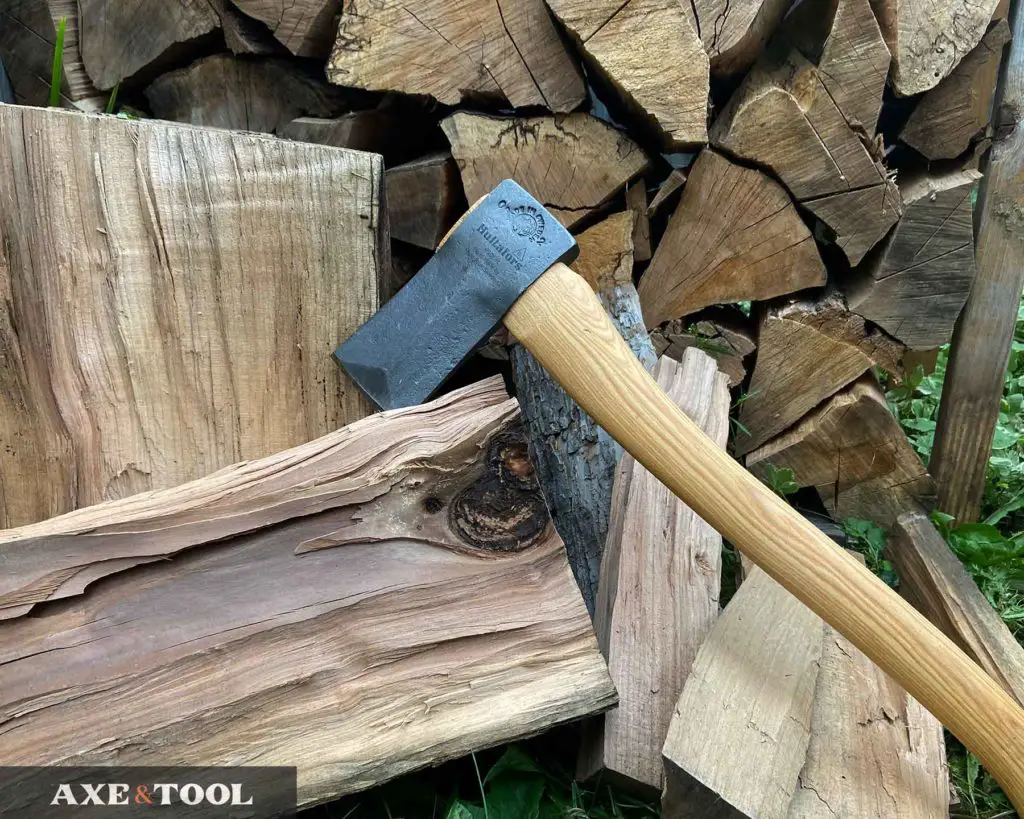
There are splitting axes in both lines, but there aren’t as many differences as in the felling axes. All the models use the same pattern of splitting heads, it’s just the details and finishing level that sets them apart.
The heads are rectangular with a unique diamond-shaped bit with the raised spines running down the middle of the cheeks.
To be honest, this pattern is not my favorite splitting design. It works, but the diamond shape means the thinner blade edges can get stuck if you don’t land the swing accurately. I prefer the Fiskars and Gransfors Bruk flared cheeks that cover more surface area and flare out.
The big difference is the sharpness. The premium splitting axe has a sharp convex edge to penetrate the wood – which is important because it needs to drive in before the expanding cheeks can pry the wood apart.
My standard splitting axe came with a really wide edge grind, that needs additional sharpening before use. Maybe it was just the axe I got, but mine came with a 60-degree cutting edge, and it just bounced off most wood.

Once sharpened it worked much better, but it really needed that extra work.
Otherwise, the premium axes have a nice black forged finish on the heads, finer handles, and come with a sheath – just like the felling axes.
| Premium splitting axes | Type | Head | Handle |
|---|---|---|---|
| Hults Splitting | Splitting | 3.5lb | 30″ |
| Standard splitting axes | Type | Head | Handle |
|---|---|---|---|
| Splitting Axe SV | Splitting | 2lb | 20″ |
| Splitting Axe RA | Splitting | 3.5lb | 30″ |
| 5lb Splitting Maul | Splitting | 5lb | 30″ |
The big splitting maul has the same profile bit, but it has a big sledge back to it, so it can be hammered on (or used as a hammer).
Specialized Models
Hultafors Carpenters Axes
There are both Premium and Standard carpenter’s axes with large thin bits, and a large finger groove to really allow for fine carving and shaping.
Hultafors Double-bit Axe
This axe is a bit of a recreational tool, as it’s marketed as a large throwing axe. It has a bit of a swamping pattern head, with big curved blades.
Premium specialized axes
| Model | Type | Head | Handle |
| Wetterhal | Double Bit | 3.75lb | 30″ |
| Stalberg | Carpenters | 1.75lb | 20″ |
Standard specialized axes
| Model | Type | Head | Handle |
| SY 21-0,8 SV | Carpenters | 1.75lb | 20″ |
| SY 21-0,8 RA | Carpenters | 1.75lb | 20″ |
The “SV” axe has a standard curved handle, and I have seen it used as a cheaper bushcraft and carving axe. The “RA” version has a more traditional straight handle like the premium model.
Agdor Axes
Like I mentioned before, Hults Bruk makes the Hultafors axes, as well as making axes under a few other brands. Agdor, Arvika, and Husqvarna.
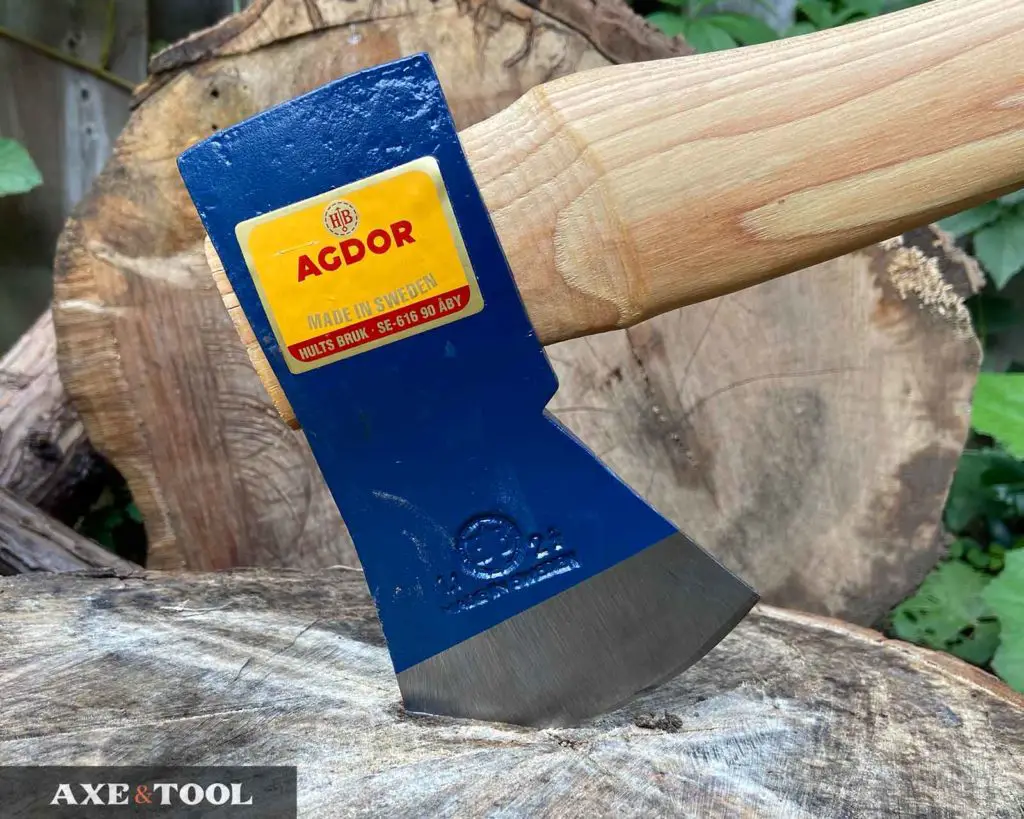
My personal favorites are the Agdor axes. They are basically the same as the standard axes and come with a brilliant blue head and a few unique patterns like there are 2.5lb and 3.5lb Montreal pattern axes and a Big 4.5lb Tasmanian.
In the USA (where the brand is Hults Bruk), the Agdor axes have replaced the standard line of axes all together.
If you are curious about the unique patterns I have an illustrated breakdown showing the differences between the Yankee and Montreal Patterns.
About the author:
About the author:
Jim Bell | Site Creator
I’m just a guy who likes axes. I got tired of only finding crap websites, so I set out to build a better one myself.
I’m also on Instagram: @axeandtool



Good job on the information provided. Thank you
Thanks, appreciate it!
Thank you!! This was really help me to choose the right axe (for me).
Awesome! Glad you found the post helpful.